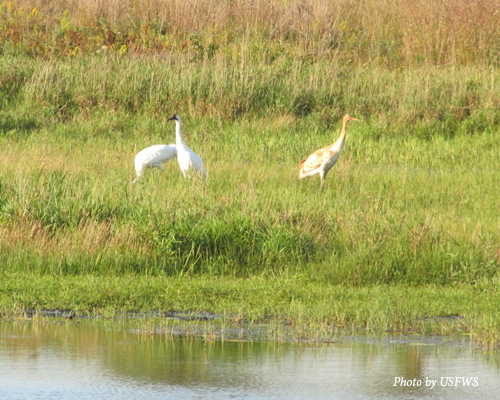 Members of the Whooping Crane class of 2015 are getting ready for their next big adventure.
Members of the Whooping Crane class of 2015 are getting ready for their next big adventure.
For the first time in their young lives they’ll learn to fly to their wintering grounds in the central and southeastern United States, another crucial step in efforts to re-establish a migratory population in the eastern half of North America. Hatched and raised in a variety of settings to increase the cranes’ overall chance for survival, the Whoopers also will reach their destinations in a variety of ways:
Six young cranes hatched earlier this year at Patuxent Wildlife Research Center in Laurel, Maryland are already on site at the White River Marsh State Wildlife Area in Green Lake and Marquette County in eastern Wisconsin where they are training to fly behind an Operation Migration ultralight aircraft. That flight will start in late September and is expected to take six to 16 weeks depending upon weather conditions.
Eight young cranes hatched in captivity earlier this year at the International Crane Foundation in Baraboo, Wisconsin and raised by costumed handlers will be released at Horicon Marsh National Wildlife Refuge in eastern Wisconsin in October to mingle with, and hopefully make the migration south, with adult Whooping Cranes.
Three birds that were hatched in captivity at Patuxent and raised by captive crane parents there will be released at Necedah National Wildlife Refuge in central Wisconsin in September and will hopefully follow migrating adults in October.
Three Whoopers hatched in the wild at Necedah National Wildlife Refuge have fledged and will likely follow their parents along the route (above right).
“We’ve achieved a lot of milestones with the class of 2015 and are hopeful these young birds can make it safely to their wintering grounds and help us build the flock,” says Davin Lopez, a conservation biologist for the Wisconsin Department of Natural Resources, one of the partners in the Whooping Crane Eastern Partnership that is working to establish a flock in the eastern United States.
Joe Duff, Operation Migration co-founder and chief executive officer, says the young Whoopers now training with ultralights “make up one of the best, most attentive cohorts we’ve ever had the honor of working with.”
“All six are very attentive to the aircraft and currently can fly for up to 30 minutes at a time,” he says. “We anticipate beginning the southward migration to the St. Marks National Wildlife Refuge south of Tallahassee on September 20, provided the weather cooperates.”
Milestones achieved but chick survival remains a challenge
A fixture in North American skies and wetlands for millions of years, Whooping Cranes verged on extinction in the 1940s due to unregulated hunting and habitat loss. U.S. and Canadian protections and management, including a Whooping Crane Recovery Program, have slowly increased the remaining flock. To reduce the species’ vulnerability, the Whooping Crane Eastern Partnership came together to establish a second migratory flock. After initial attempts failed in Idaho, Wisconsin was chosen as the summer site for the flock.
Here, the Whooping Crane Eastern Partnership has succeeded in building an eastern migratory flock of nearly 100 whooping cranes. The project has also pioneered methods for raising Whooping Cranes and helping teach them their migratory routes.
Lopez says 2015 saw a record number of nests in the wild, a record number of chicks hatched, a record number of fledglings, and none of the nest abandonment problems of past years.
“We’re seeing a lot of positives and we’re learning a lot about reintroductions that will not only help the Eastern Partnership project but will also help the efforts in Louisiana to establish a non-migratory population of Whooping Cranes there,” Lopez says.
Studies are ongoing to try to better understand what predators may be posing a problem for chick survival, and the partners are convening a group of experts from across the nation to explore possible causes and solutions.
Black flies, which had contributed to nest abandonment at Necedah in past years, weren’t a problem this year. The flies didn’t emerge in large numbers this summer and there were good hatching rates, although chick survival was not what the partners had hoped for.
“The partnership continues to overcome hurdles and make progress toward establishing a self-sustaining eastern migratory flock,” Lopez says.
“This is a cutting-edge species recovery project, and we’re getting closer and closer to achieving what one U.S. Fish and Wildlife Service (USFWS) official described as, “the wildlife equivalent of putting a man on the moon.”
